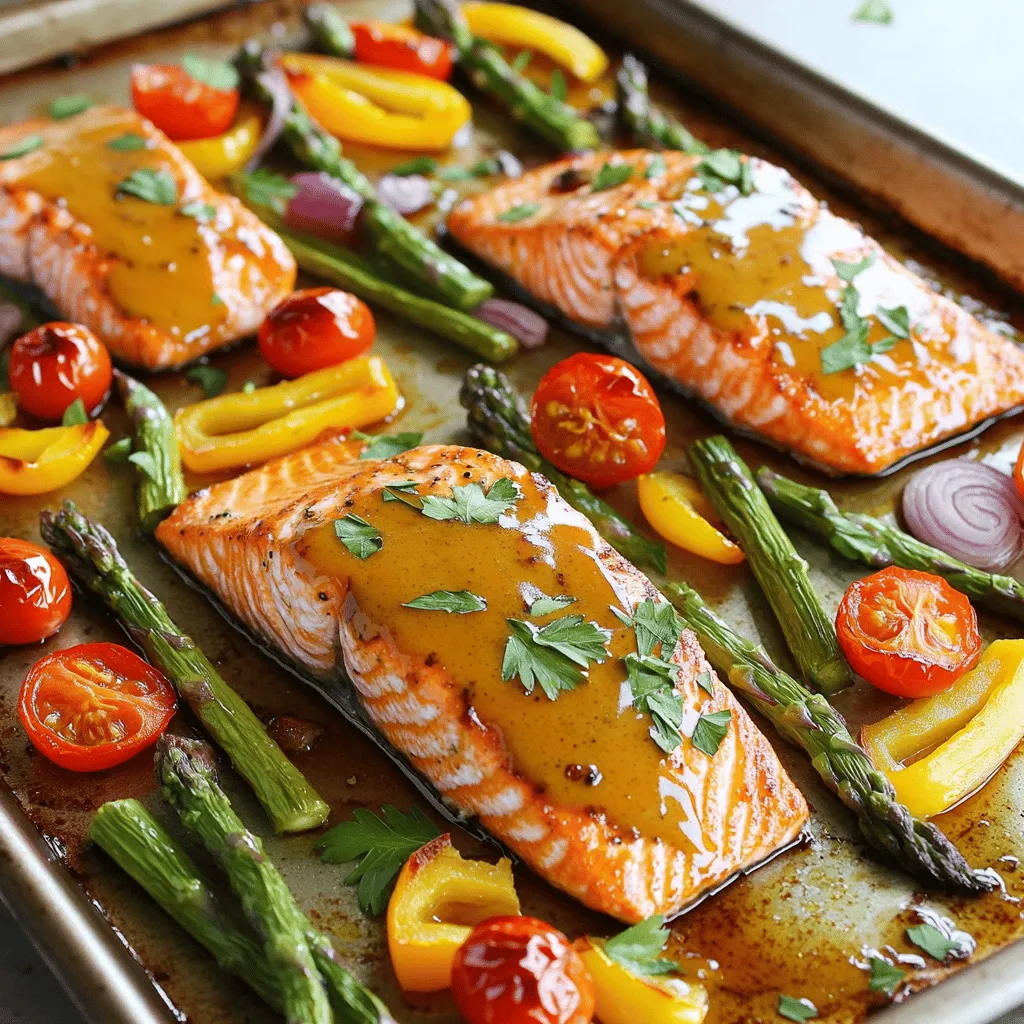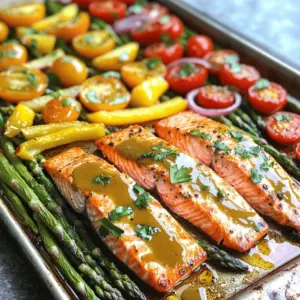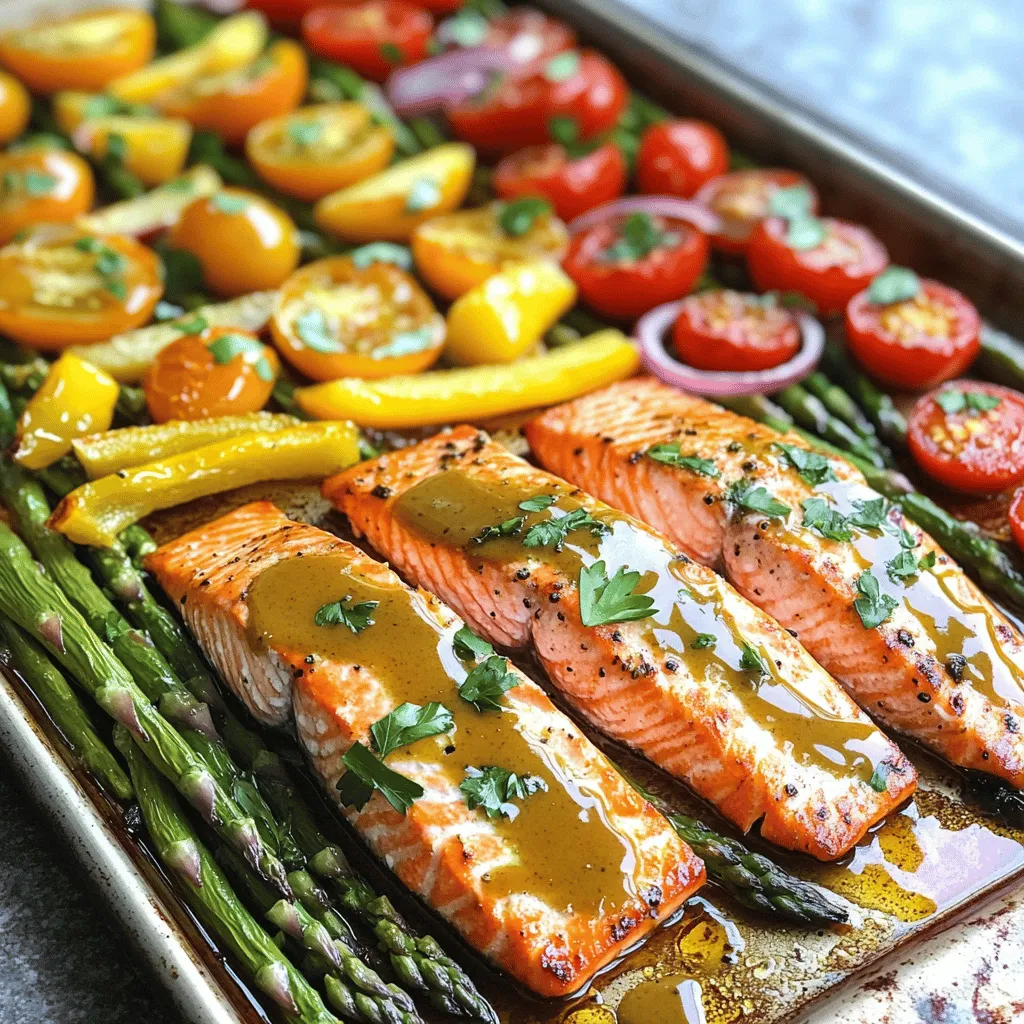Welcome to your new favorite dinner recipe: Maple Roasted Salmon & Veggies Sheet Pan Delight! This dish combines tender salmon with bright veggies, all drizzled in a sweet and tangy glaze. It’s simple to make, healthy, and perfect for busy weeknights. In this article, I’ll guide you through easy ingredients, step-by-step instructions, and helpful tips. Get ready to impress your family with this colorful, delicious meal!
Ingredients
Main Ingredients for Maple Roasted Salmon
– 4 salmon fillets (approximately 6 oz each)
– 2 tablespoons pure maple syrup
– 2 tablespoons Dijon mustard
Vegetables to Use
– 1 bunch of asparagus, trimmed at the ends
– 1 red or yellow bell pepper, sliced into thin strips
– 1 cup cherry tomatoes, halved
– 1 red onion, sliced into wedges
Seasoning and Garnish
– 2 tablespoons olive oil (plus more for drizzling)
– 1 teaspoon garlic powder
– 1 teaspoon smoked paprika
– Salt and freshly ground pepper to taste
– Fresh parsley, finely chopped (for garnish, optional)
Using these simple ingredients makes this dish easy and tasty. The salmon fillets are rich and flavorful. Maple syrup adds a sweet touch. Dijon mustard gives a nice tang that balances the sweetness.
The veggies bring color and crunch to the meal. Asparagus is bright and tender. Bell peppers add sweetness and a pop of color. Cherry tomatoes burst with flavor. Red onion gives a slight sharpness to the mix.
Seasoning is key. Olive oil helps everything cook well. Garlic powder adds depth. Smoked paprika gives a warm, smoky flavor, making this dish special. Fresh parsley on top adds a fresh look and taste.
This sheet pan meal is perfect for any night. You get healthy protein and veggies all in one dish. Plus, cleanup is a breeze!
Step-by-Step Instructions
Preparing the Oven and Ingredients
First, you need to preheat the oven to 400°F (200°C). This step is key for getting a nice roast on the salmon and veggies. While the oven heats up, let’s mix the maple mustard glaze. In a small bowl, combine:
– 2 tablespoons pure maple syrup
– 2 tablespoons Dijon mustard
– 2 tablespoons olive oil
– 1 teaspoon garlic powder
– 1 teaspoon smoked paprika
– Salt and freshly ground pepper to taste
Whisk everything together until you have a smooth mixture.
Arranging the Vegetables
Now, grab a large sheet pan. Spread the vegetables on it in a single layer. Use:
– 1 bunch of asparagus, trimmed
– 1 red or yellow bell pepper, sliced into strips
– 1 cup cherry tomatoes, halved
– 1 red onion, sliced into wedges
Drizzle some olive oil over the veggies. Sprinkle with salt and pepper. Toss them lightly to coat all the pieces.
Cooking the Salmon and Vegetables
Next, it’s time to place the salmon. Make some space in the center of the veggies and lay down 4 salmon fillets skin-side down.
Now, take your maple mustard glaze. Coat the top of each salmon fillet generously. Let some glaze drip onto the veggies as well.
Finally, put the sheet pan in the preheated oven. Roast for about 15-20 minutes. You know it’s done when the salmon looks opaque and flakes easily with a fork. The veggies should be tender and slightly caramelized.
Once finished, take the pan out of the oven. Let it rest for a few minutes. This step helps the juices settle. If you like, sprinkle some fresh parsley on top for a nice touch before serving. Enjoy your delicious meal!
Tips & Tricks
Achieving Perfect Roasted Salmon
How do you check for doneness?
To check if your salmon is done, use a fork. Gently poke the thickest part. If it flakes easily, it’s ready. The salmon should look opaque and slightly moist.
Why is resting important before serving?
Resting allows the juices to settle. If you slice right away, the juices run out. Let it sit for about 5 minutes after cooking. This helps keep your salmon juicy and tasty.
Enhancing Flavor Profiles
What spices and seasonings work well?
You can add a pinch of cayenne for heat. Fresh dill or thyme also pairs well. Try adding lemon zest for brightness. These flavors make your dish pop.
What should I pair with this meal?
A light salad goes great with this dish. Consider a simple green salad with lemon vinaigrette. You can also serve it with rice or quinoa for a heartier meal.
Visual Presentation Advice
How can I serve it for appeal?
Serve directly on the sheet pan for a rustic look. Or, transfer it to a large platter. Make sure the veggies surround the salmon. This adds color and height to your dish.
Why is color important in food presentation?
Color makes food visually appealing. Bright veggies like red bell peppers and cherry tomatoes attract the eye. A colorful plate also signals freshness and health. Aim for a mix of greens, reds, and yellows for a vibrant meal.

Variations
Alternative Vegetables to Consider
You can switch up the veggies for your maple roasted salmon. Here are a few tasty options:
– Broccoli or green beans: Both add a nice crunch and color to your dish.
– Zucchini or squash: These cook quickly and soak up flavors well.
Feel free to mix and match. You can use what you have on hand!
Different Marinades for Salmon
If you want to change the flavor of the salmon, try these marinades:
– Teriyaki glaze variation: This adds a sweet and savory taste. Just swap the maple syrup with teriyaki sauce.
– Lemon herb alternative: Use lemon juice with fresh herbs like dill or parsley. This gives a bright and fresh flavor.
Experimenting with marinades can take your dish to the next level!
Adjustments for Dietary Needs
Making this dish fit your diet is easy. Here are a few tips:
– Gluten-free options: Check your Dijon mustard and maple syrup for gluten. Most brands are safe, but it’s good to be sure.
– Low-carb modifications: Skip the maple syrup. Use a sugar substitute like stevia or erythritol. This keeps the dish low in carbs while still being tasty.
These adjustments let everyone enjoy this meal while sticking to their dietary needs!
Storage Info
Best Practices for Refrigeration
To store leftovers safely, let the salmon and veggies cool first. Place them in airtight containers. This keeps them fresh and prevents any strong odors in your fridge. Use glass or BPA-free plastic containers for the best results.
Reheating Instructions
To reheat without drying out, use the oven. Preheat it to 350°F (175°C). Place the salmon and veggies on a baking sheet. Cover with foil to keep moisture in. Heat for about 10-15 minutes, or until warm.
You can also use a microwave. Put the food on a microwave-safe plate. Cover it with a damp paper towel. Heat it in short bursts of 1 minute, checking often. This method is quick but may dry out the fish if overcooked.
Freezing Information
For freezing, let the cooked salmon and veggies cool completely. Wrap them tightly in plastic wrap or foil. Then, place them in a freezer-safe bag. Label the bag with the date. Cooked salmon can last up to 3 months in the freezer.
When you’re ready to eat, thaw in the fridge overnight. This helps maintain texture and flavor. Avoid thawing in the microwave, as it can cook parts of the fish unevenly.
FAQs
How long does salmon take to cook at 400°F?
Salmon usually takes 15 to 20 minutes to cook at 400°F. The fish should look opaque and flake easily with a fork. This time can vary based on the thickness of the fillet. If your salmon is thicker, it may need a bit more time. Keep an eye on it to avoid overcooking.
Can I use frozen salmon for this recipe?
Yes, you can use frozen salmon. To prepare it, thaw the salmon in the fridge overnight. If you are in a hurry, you can also run it under cold water for about an hour. Once thawed, pat it dry and follow the recipe as usual. This way, you still get great flavor and texture.
What can I substitute for maple syrup?
If you don’t have maple syrup, honey works well. You can also use agave nectar or brown sugar mixed with a little water. Just remember, these sweeteners might change the taste a bit. Adjust the amount to your liking, as some are sweeter than others.
Is this recipe healthy?
Yes, this recipe is healthy. Salmon is rich in omega-3 fatty acids, which are great for your heart. The veggies add vitamins and fiber, making it a balanced meal. Olive oil is a healthy fat that helps with nutrient absorption. Overall, this dish is nutritious and delicious.
This post covered a tasty recipe for maple roasted salmon. We discussed the main ingredients, perfect veggies, and how to season. I shared step-by-step instructions to make cooking easy. You also received tips for storage and reheating.
In the end, this dish is simple and colorful. It’s great for meals any day. Plus, you can mix it up with different flavors or sides. Enjoy experimenting, and make it your own!

